Human Resource Management Information Sample Assignment
Human Resource Management
1. Executive Summary
The purpose of the report is to understand the changes to be made in the human resource policies and practices of a company while they decide to expand into international territories. As Tesco has decided to enter the Chinese retail market by getting into a joint venture with Alibaba, the human resource management of the company has to decide on the policies to effectively manage the UK and Chinese employees. The company chose China as it has the second largest retail market, however, the cultural difference pose as an obstacle. However, after evaluating the findings of cultural and organizational culture differences using Hofstede and Handy’s model respectively, Tesco has decided to follow the internal and external recruitment and selection technique. Along with this, the company would use off-the-job and on-the-job training and development technique and intrinsic and extrinsic reward management system. All the methods would help the company to positively influence the organizational performance, employee commitment, workforce flexibility and workforce quality.
2. Introduction
Human resource management is defined as a distinctive approach used for employment management. The motive of the approach is to gain a competitive edge in the industry by strategically deploying capable and highly committed workforce by an integration of personnel, cultural and structural techniques (Osibanjo et al., 2014). In the present times, the global labour markets have become extremely dynamic in nature. The organizations have to deploy strategic machinery for managing their workforce so that they can manage the employee diversity. Moreover, as organizations expand into international territories, managing workforce have become more of a crucial task. The cultural barriers and methods of managing business are different in every country and therefore, workforce management is become extremely challenging and important.
The purpose of the report is to highlight the various workforce and human resource management techniques required for dealing with a diversified workforce. The report would discuss the techniques based on the case study of Tesco. Earlier, when Tesco opened its store in China, they failed to garner customers and revenues as they were unable to adapt to the cultural differences. Therefore, the management has Tesco has decided to venture into the Chinese markets by forming a joint venture with Alibaba. Therefore, the report would contain the strategies required for managing the Chinese and UK workforce.
3. Company profile
A British international general merchandising and grocery retail chain, Tesco was founded in the year 1919.The company is listed in the London Stock Exchange and is headquartered in Chestnut, UK. The largest operations of the company are conducted in UK with 300,000 employees working for the company in about 34000 stores. The vision of the company is to introduce competitive offers in the market for their customers by delivering affordable prices, premium quality, wider product portfolio and improved services (Tesco plc, 2019A).
Tesco operates with the motive of “Serving shoppers a little better every day”. The mission of the company is being the champion for their customers by helping them live an easy and better quality life. The company serves around 66 shoppers every second, with the goal of providing them utmost satisfaction while shopping in the retail outlets (Tesco plc, 2019B). With regards to customers, the company operates on the core principle of – understanding customers, being the first one to meet their needs and acting responsibly towards the community. The group sales of the company for the year 2017-18 accounted to £51 billion and an operating profit of £1837 million (Tesco plc, 2019C).
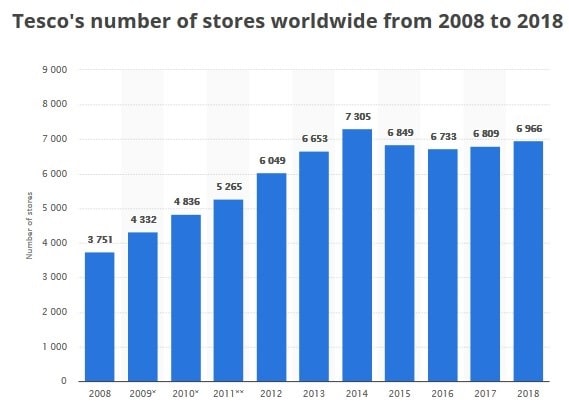
Figure 1: Number of Tesco stores worldwide
(Source: Statista, 2019A)
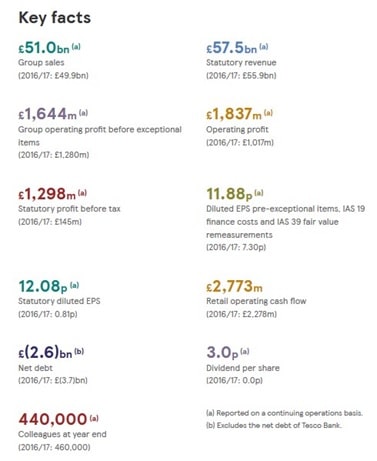
Figure 2: Key financial facts about Tesco
(Source: Tesco plc, 2019C)
Using the baton of globalization, Tesco has expanded its operations into various other international countries, namely – Hungary, Poland, Ireland, Slovakia, Thailand, Malaysia, Japan, South Korea and many more. Therefore, in order to manage smooth operations in several countries, Tesco has developed a set of principles for dealing with its employees. The company believes in working in a team and developing a strong team dynamics involving mutual respect and trust. The company encourages their colleagues to evolve with time by continuously exchanging knowledge and experience as it would foster personal and professional growth.
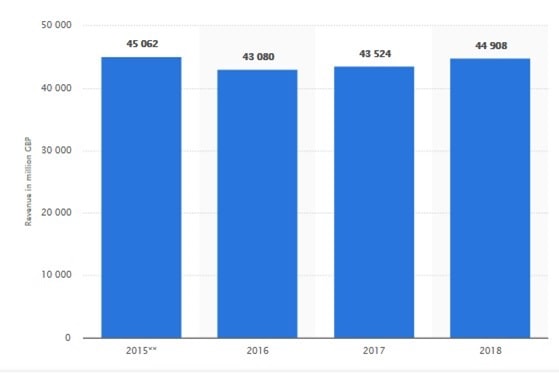
Figure 3: Annual revenue of Tesco in UK from 2015-2018
(Source: Statista, 2019B)
4. Industry drivers
a. Host country profile
In the last decade, profound changes have been witnessed in the retail markets of China. After the country opened its economy for global exposure, several international companies entered the Chinese markets and brought in new managerial approaches and advanced retail techniques into the scene. These advancements helped the domestic retailers of the country to grow and develop a sophisticated supply chain management. The international retailers operating in the Chinese markets work mostly in supermarket and hypermarket formats as they offer high quality products at extremely affordable rates (Hingley et al., 2009).
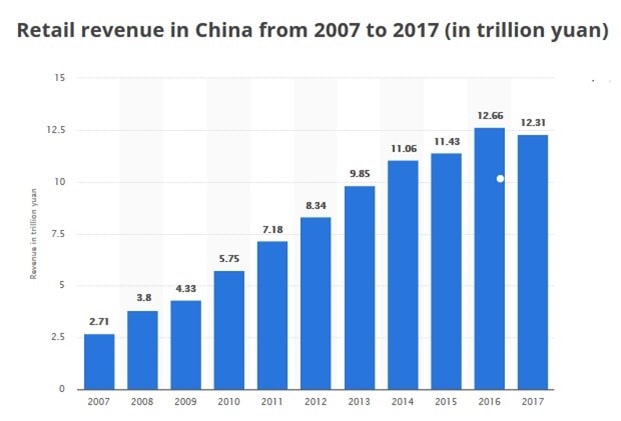
Figure 4: Revenue from retail industry
(Source: Statista, 2019C)
The motivation of the international organizations opening their stores in China is that the countries retail industry is the second largest in the world. In the year 2017, the country registered total revenue of 36.6 billion Yuan by selling consumer goods. Moreover, in the year 2018, the percentage of retail sales of consumer goods is expected to rise by 9.4%making it 18 trillion Yuan (Fbicgroup.com, 2019). Another reason making the retail industry of China attractive is the use of advanced technology. China is known to be a technologically advanced country with every business format being technologically driven. The retailers of the country have managed to integrate the physical formats of the store with the online platform providing increased customer experience. Moreover, the gross domestic product of the country as of 2017 was $23.12 trillion making the economy strong.
b. PESTEL analysis
Political: In the last 30 years, the political condition of China changed profoundly. The country was earlier dictated by monarchy solely, however, in the present times, they operate on fundamental political system. Earlier, the country’s economy was close and restricted, however, now the government has opened doors for the international companies to invest in China. The government of the country is promoting modernization and changing their trade regulations to suit international trade. Moreover, China and UK share amicable trade relations.
Economic: The gross domestic product of the country as of 2017 was $23.12 trillion and a population of 1390 million. The economy of the country is growing stronger by each passing year with an increase witnessed in the domestic demands. The retail economy of the country is branded to be the second highest in the world making it an attractive industry to venture into. Additionally, the taxation policy and trade regulations of the country have become business friendly. The availability of fresh products suppliers in China makes the retail industry strong and viable.
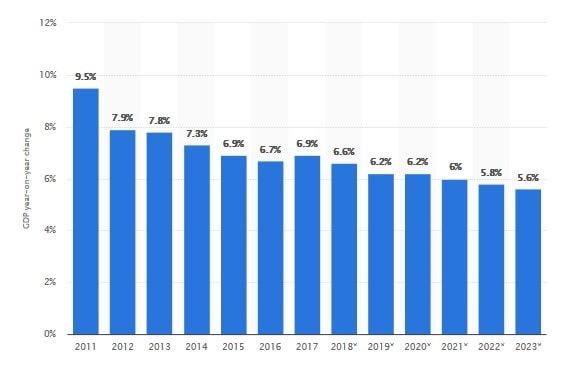
Figure 5: China’s real GDP growth rate
(Source: Statista, 2019D)
Social: In terms of population, China occupies the first position in the world, with a current (Worldometers.info, 2019) population of 1,418,599,017, making it equivalent to 18.41% of the world population. The population explosion in the country increases the demand for retail stores and items. Moreover, the consumers have become extremely dependent on the hypermarket and supermarket formats of stores along with online platforms. However, the Chinese people are extremely particular about their culture and forcing foreign culture and format on them could turn out be negative. Hence, the retailers would have to respect the Chinese culture while conducting trade operations.
Technological: China is known to be a technological modern country with several innovations stemming from the soil. The physical and technological infrastructure of the country is extremely strong making the distribution and supply chain management easy. The use of modern technology is observed in every aspect of Chinese trade, which has lead to increase in the standard of living. Moreover, online sales have also received an impetus in the last few years.
Environmental: The Chinese government has come up with new laws and regulations regarding waste management, which has to be abided by all companies. Recently, the government abolished the use of plastics, due to which the retail companies had to shift to paper bags. Moreover, the retail stores have to track their pollution rate so that they manage the rate and not add on to it. Similarly, the Chinese lay increased focus on waste recycling.
Legal: The legal policies of the country are extremely stringent and restricted. The government has made strict laws for the international companies working in China so that they can protect the resources of the country from getting exploited. The legal regulations have a direct impact on the functioning of the foreign companies as it makes procurement of resources a bit difficult. Moreover, the license requirements of the country are mandatory to abide for the retailers to ensure a smooth supply chain management.
c. Why to go there?
As discussed above, the Chinese markets are an attractive and lucrative option to venture into as it is the second largest retail industry around the globe and contains a huge population leading to high demand of consumer goods. The gross domestic product of the country is strong and backed up by financial assistance from the government. As the country was operating in a close economy model for several years, it contains untapped demand, which when explored can boost the sales and profits of the international organizations. Additionally, as Tesco aims to expand into international markets, China would be a suitable option for them.
Earlier, Tesco failed in the Chinese markets as they were unable to understand the Chinese culture. Therefore, this time, Tesco has decided to venture into the Chinese markets by forming a joint venture with Alibaba, an e-commerce company based out of China. This would help the company to reach out to the Chinese customers more easily. Moreover, the technological advancements of the country are strong enough to allow online retail trade. A sharp increase has also been seen in online sales making it a viable option for Tesco to invest in.
5. HR theories
Strategic human resource management is defined as achievement of company objectives through integration of Hr policies and strategies. The aim of strategic HRM is to align the business policies and methods with HR policies so that the employees can be motivated and trained to achieve the goals. The strategic HRM operates on the lines of best practice approach wherein, the HR practices are considered to be universal and application of them in any situation is considered to reap benefits for the company. The three main categories of strategic human resource management are – universalistic, contingency and configurational approach.
Universalistic Approach
As per this approach, there are several human resource practices, which would suit any organizational situation. It operates on the line of best practice, which states that human resource practices in relation to training and development, employee motivation and recruitment and selection would reap same results in every situation irrespective of the resources of the company, its nature of operations and location (Dudovskiy, 2013). It assumes a universal relationship between firm performance and individual best practices. This is also regarded as the best practice approach.
Contingency Approach
This perspective of strategic human resource management disagrees with the universalistic approach. As per the contingency or the best fit approach, the organizations have to ensure consistency of the human resource policies with the other organizational aspects by aligning them with each other. This approach lays stress on vertical fit, wherein, the resources, functions, location, modus operandi and other factors of the organization are explored and integrated with the human resource policies and practices for reaping higher results.
Configurational Approach
This approach of strategic human resource management recognizes the need of those practices, which are contingent with the circumstances of the company along with focussing on the need for internal or horizontal fit. It is a holistic perspective where the link between independent and dependent organizational variables is determined to judge the performance of the company. It is also known as the bundling approach (Nscpolteksby.ac.id, 2019A).
As per the current scenario, the human resource management of Tesco should adopt the configurationally approach for venturing into the Chinese retail market. The bundling approach of strategic human resource management would assist the company in determining the independent and dependent variables, which might cast an influence on the human resource policies of the company. While entering the Chinese markets, the company would have to make changes in their employee policies and practices so that they can manage the cultural differences meticulously. As the Chinese markets and culture is extremely different from UK, adopting the configurational approach would allow the company to make changes in the HRM practices as per the situation. Adoption of universalistic approach could have lead to downfall of the company as the practices, which worked for Tesco in UK would not have managed to reaped the same results in China due to cultural differences. Similarly, vertical fit through adoption of contingency approach would not allow the company to adapt to the situation completely. Hence, configurational perspective would help the company to fit into the Chinese markets properly by adopting to the local policies and situations.
6. HRM strategy
a. Recruitment and selection
Recruitment is defined as the process to identify, screen, shortlist and hire potential employees for the right job at the right times. It is a positive function of HRM wherein profiles of several candidates are considered for filling the vacancy (O'Meara and Petzall, 2013). On the other hand, selection is defined as the process of picking the right candidate most suitable for the position from a pool of applications. It is a negative process wherein, the applications of candidates are rejected to hire the most suitable one.
As Tesco, plans to enter the Chinese market sorting the joint venture mode of entry; they would need to recruit new employees for their Chinese operations. As per the decision of the company, few of the employees would be expatriated to China using internal recruitment technique as they are aware of the company policies and functioning. These employees would ensure that the company goals are being achieved and policies are being adhered. Additionally, the company would also hire local employees from China using the external recruitment technique.
However, it is important to understand the implication of the decision of the following factors:
i. Organisational Performance
The organizational performance of any company depends on the employees’ performance and expertise levels. Therefore, Tesco needs to ensure that they send those managers who are loyal to the company and would strive hard to ensure success of the company in foreign land. Moreover, the local employees hired should also possess the required skills and knowledge in their functional domain. As per the findings of the Hofstede model, which highlights the cultural differences between the countries, China scores a low score of 24 on Indulgence index proving it to be a restrained economy (Hofstede Insights, 2019). Hence, it is perceived that Chinese people put less emphasis on personal desires and gratifications. However, UK scores 69 on the indulgence index making them delve more into leisure activities. Therefore, the HR department of Tesco has to be careful while sending expatriating employees to China. They should select and send those employees who are highly committed towards company success and have a mindset similar to the Chinese people. Such a workforce would ensure high organizational performance.
ii. Employee Commitment
For an organization to be successful, they need to have a committed workforce. If the findings of the Hofstede models are put into consideration, it is observed that both China and United Kingdom score the same in terms of masculinity, which specifies the motivation of the people to achieve success by prioritising work and curbing down on leisure activities (Core.ac.uk, 2019). Hence, by using internal and external recruitment techniques, Tesco would hire a committed workforce since people of both the countries are success driven and goal-oriented. Hence, if the company is able to recruit the right mix of employees, they would flourish in the new market.
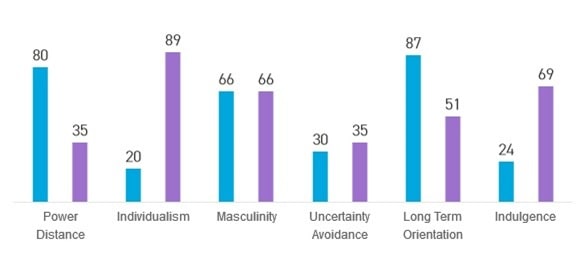
Figure 6: Hofstede country comparison between UK and China
(Source: Hofstede Insights, 2019)
iii. Workforce Flexibility
The workforce flexibility would mean change in the workforce as per the needs of the market. It is primarily categorized by lower employee costs and payroll. The impact of recruitment and selection strategy on employee flexibility can be measured using the long-term orientation index of the Hofstede model. This orientation mentions that the society maintains links with the past while they deal with the challenges of the future and present. China scores 87 in this index making it a pragmatic society wherein people prefer following traditions rather than adopting to situations (Hofstede Insights, 2019). Moreover, UK scores 51, making their position undetermined. Hence, the company would find it difficult to manage workforce flexibility as Chinese people do not prefer changing with situations. Therefore, the company would have to work on this aspect.
iv. Workforce Quality
Workforce quality includes skills of the employees such as interpersonal skills, self management techniques, technical abilities and others. Hence, the company needs to ensure that they send employees, which are competent to manage themselves in the foreign territory while managing the local operations. A right mix of expatriate and local employees would ensure high workforce quality as the employees of UK and China are said to be success driven and motivated.
b. Training and development
As per Psnacet.edu.in (2019), training is defined as the systematic and formal modification of employee behaviour through the process of learning. On the other hand, development is defined as the activity directed towards future rather than fulfilment of present needs that help the employees to grow professionally and enhance their career performance. Training has direct implication on health and safety policies, productivity and personal development of the employees (Www2.le.ac.uk, 2019). The human resource managers of Tesco would have to use both on-the-job and off-the-job training methods for their Chinese ventures. Firstly, the employees who would be sent from UK would have to be trained off-the-job regarding the Chinese language and culture so that they can fit into the environment. On the other hand, the local Chinese employees would have to be trained on-the-job so that they understand their work and help the company in achieving the goals.
i. Organisational Performance
The organizational performance of Tesco in the Chinese markets would depend on the attitude of the employees. In order to ensure that the resources of the company are being used to its optimum level, the employees both expatriated and locals have to be trained well. Adopting the off-the job and on-the-job training and development techniques might prove to be helpful for the company. For instance, if all the employees were trained on site about their work, then they would have a first-hand experience, which would enhance their work quality. Therefore, decision taken by the company with regards to training and development techniques would cast a positive influence on the organizational performance of Tesco in China.
ii. Employee Commitment
As per the analysis of the Hofstede model, China scores as low as 20 in the individualism index signifying that the Chinese believe in collectivist culture and focus more on the interests of the group rather than individual desires. Hence, the employee commitment among the Chinese workforce is said to be low as their relations with the colleagues are mostly hostile and the personal relations prevail over the company. However, UK scores high in individualism index, making the workforce of Tesco diverse. Hence, the training methods would turn out to be less effective for the company with regards to employee commitment.
iii. Workforce Flexibility
In UK, Tesco follows the people culture as per the model of Charles Handy. As per the person culture, the focus on laid implicitly on the employees’ welfare and growth so that they feel an important part of the company and contribute their best. However, in China, the company would have to adopt the power culture as the Chinese prefer task oriented approach. Hence, the training decisions taken by the company would prove to be fruitful, as they would be able to train their UK employees regarding the change in organizational culture in the Chinese continent.
iv. Workforce Quality
The training and development choices made by Tesco would have a positive influence on the quality of the workforce in the Chinese venture of the company. As the company would be able to train their employees properly using both the techniques, their employees would be informed about everything in advance. Moreover, the on-the-job technique would provide real experience to their employees leading to enhanced productivity (Qin et al., 2015).
c. Reward management
Reward management is defined as the implementation of policies and strategies through which the company decides to reward their employees based on their performance and skills (Nscpolteksby.ac.id, 2019B). With the changing dynamics in the labour markets, it has become mandatory for the companies to introduce reward management system so that they can keep their employees motivated and focused on achieving the organizational goals. The human resource management of Tesco has decided to deploy both intrinsic and extrinsic reward strategy to reward their employees. The extrinsic reward would include bonus, salary hike, promotion, gifts and other tangible rewards. On the other hand, the intrinsic rewards would include performance feedback, recognition, empowerment and others (Shields et al., 2015).
i. Organisational Performance
The reward management strategy decided by Tesco would prove to be fruitful. As the employees would be rewarded for their efforts, they would feel motivated and perform better leading to optimum use of resources. As the employees of both the countries are said to be success driven, the company can be assured about high quality work. Moreover, in China, the people do not believe in reducing the inequalities in work leading to them following the orders of their subordinates. Hence, this means that they would follow the UK managers would not face difficulty in managing Chinese employees leading to high organizational performance.
ii. Employee Commitment
The reward management technique would help the company in garnering high levels of employee commitment. As the employees would feel valued for their efforts, they would want to deliver their best performance so that they can deserve the reward in return. As the difference in power culture is being addressed, the Chinese workers would follow every order and help the company in achieving their targets.
iii. Workforce Flexibility
Flexibility in workforce poses as in issue in case of dealing with the Chinese employees. The people are China prefer following traditions and are not open to change. However, the lucrative reward management technique might entice the workers to adapt to the change easily. Hence, the reward management technique might prove to be helpful for the company is they are able to implement the idea properly.
iv. Workforce Quality
The workforce quality would definitely improve post the formulation and implementation of effective reward management system. As the company would use the soft HRM practice, wherein the employees are treated as the valuable assets of the company, the employees would feel valued. Moreover, proper recruitment and training would facilitate this function and ensure that the resources of the firm are being used wisely and optimally.
7. Conclusion
The report entails detailed discussion on human resource strategy with relevance to cross border employee management. Citing the case example of Tesco venturing into the Chinese markets, the methods of employee management have been discussed. The report states that Tesco should adopt soft human resource management model and treat their employees as asset and not mere means of earning profits. Moreover, the implications of reward management system, training and development method and recruitment and selection techniques on organizational performance, workforce quality, employee commitment and workforce flexibility gave been discussed.
8. Recommendations
Tesco has once tried to venture into the Chinese retail industry but failed miserably as they were unable to adapt to the Chinese culture. They tried to force the foreign culture into the Chinese retail formats, which did not go down well with the locals. Hence, this time the company has decided to enter the Chinese retail market again but by forming a joint venture with Alibaba. This decision will prove to be fruitful for the company as working with a Chinese origin company would help employees at Tesco understand the culture and perceptions of the Chinese people better.
However, in order to ensure success, the human resource management of Tesco needs to brainstorm and formulate proper policies that would work for both British and Chinese employees. The company need to wisely choose the employees who would be expatriated. The employees to be sent to China should be adjusting in nature and more task-oriented so that they be-fit the needs of the new country. The local employees to be hired should also be skilled and knowledgeable. Similarly, the training and development sessions should also be wholesome so that all employees are trained about different cultures. The company should adopt a total rewards model as it would meet all the needs of the employees. The components of the total rewards strategy used by Tesco should include – compensation, recognition, work-life balance, benefits, performance management and talent development (Worldatwork.org, 2019). The policy would be influenced by the external factors such as cultural norms, economy, regulatory and labour markets. Adoption of this policy would help the company to ensure high levels of organizational performance, employee commitment, workforce flexibility and workforce quality.
9. References
Core.ac.uk. (2019). [online] Available at: https://core.ac.uk/download/pdf/29818879.pdf [Accessed 17 Mar. 2019].
Dudovskiy, J. (2013). Approaches to SHRM. [online] Research-Methodology. Available at: https://research-methodology.net/approaches-to-shrm/ [Accessed 17 Mar. 2019].
Fbicgroup.com. (2019). [online] Available at: https://www.fbicgroup.com/sites/default/files/SCR2018_Executive_summary.pdf [Accessed 17 Mar. 2019].
Hingley, M., Lindgreen, A. and Chen, L., 2009. Development of the grocery retail market in China: a qualitative study of how foreign and domestic retailers seek to increase market share.
British Food Journal, 111(1), pp.44-55.
Hofstede Insights. (2019). Country Comparison - Hofstede Insights. [online] Available at: https://www.hofstede-insights.com/country-comparison/china,the-uk/ [Accessed 17 Mar. 2019].
Nscpolteksby.ac.id. (2019A). [online] Available at: https://nscpolteksby.ac.id/ebook/files/Ebook/Business%20Administration/ARMSTRONGS%20HANDBOOK%20OF%20HUMAN%20RESOURCE%20MANAGEMENT%20PRACTICE/2%20-%20Strategic%20Human%20Resource%20Management.pdf [Accessed 17 Mar. 2019].
Nscpolteksby.ac.id. (2019B). [online] Available at: https://nscpolteksby.ac.id/ebook/files/Ebook/Business%20Administration/ARMSTRONGS%20HANDBOOK%20OF%20HUMAN%20RESOURCE%20MANAGEMENT%20PRACTICE/46%20-%20Reward%20Management.pdf [Accessed 17 Mar. 2019].
O'Meara, B. and Petzall, S., 2013. Handbook of strategic recruitment and selection: a systems approach. Emerald Group Publishing.
Osibanjo, A.O., Adeniji, A.A., Falola, H.O. and Heirsmac, P.T., 2014. Compensation packages: a strategic tool for employees' performance and retention. Leonardo Journal of Sciences, (25), pp.65-84.
Psnacet.edu.in. (2019).
Qin, R., Nembhard, D.A. and Barnes II, W.L., 2015. Workforce flexibility in operations management. Surveys in Operations Research and Management Science, 20(1), pp.19-33.
Shields, J., Brown, M., Kaine, S., Dolle-Samuel, C., North-Samardzic, A., McLean, P., Johns, R., O'Leary, P., Robinson, J. and Plimmer, G., 2015. Managing employee performance & reward: Concepts, practices, strategies. Cambridge University Press.
Statista R. (2019). China: retail revenue 2017 | Statistic. [online] Statista. Available at: https://www.statista.com/statistics/277810/retail-revenue-in-china/ [Accessed 17 Mar. 2019].
Statista, G. (2019). China GDP growth rate 2011-2023 | Statistic. [online] Statista. Available at: https://www.statista.com/statistics/263616/gross-domestic-product-gdp-growth-rate-in-china/ [Accessed 17 Mar. 2019].
Statista, T. (2019A). Tesco's global number of stores 2018 | Statistic. [online] Statista. Available at: https://www.statista.com/statistics/238667/tesco-plc-number-of-outlets-worldwide/ [Accessed 17 Mar. 2019].
Statista, T. (2019B). Tesco financial revenue United Kingdom 2015-2018 | Statistic. [online] Statista. Available at: https://www.statista.com/statistics/490931/tesco-group-finance-revenueunited-kingdom-uk/ [Accessed 17 Mar. 2019].
Tesco plc. (2019A). Tesco in the UK.
Tesco plc. (2019B). Core Purpose and Values. [online] Available at: https://www.tescoplc.com/about-us/core-purpose-and-values/ [Accessed 17 Mar. 2019].
Tesco plc. (2019C). Key facts. [online] Available at: https://www.tescoplc.com/about-us/keyfacts/ [Accessed 17 Mar. 2019].
Worldatwork.org. (2019). [online] Available at:
https://www.worldatwork.org/docs/marketing/1610_BRO_TRModel_Update_J5613_FNL.pdf [Accessed 17 Mar. 2019].
Worldometers.info. (2019). China Population (2019) - Worldometers. [online] Available at: http://www.worldometers.info/world-population/china-population/ [Accessed 17 Mar. 2019].
Www2.le.ac.uk. (2019). [online] Available at: https://www2.le.ac.uk/projects/oer/oers/psychology/oers/Training%20and%20Development%20Introduction%20and%20Overview/Training%20and%20Development%20Introduction%20and% 20Overview%20-%20TRF.pdf [Accessed 17 Mar. 2019].


